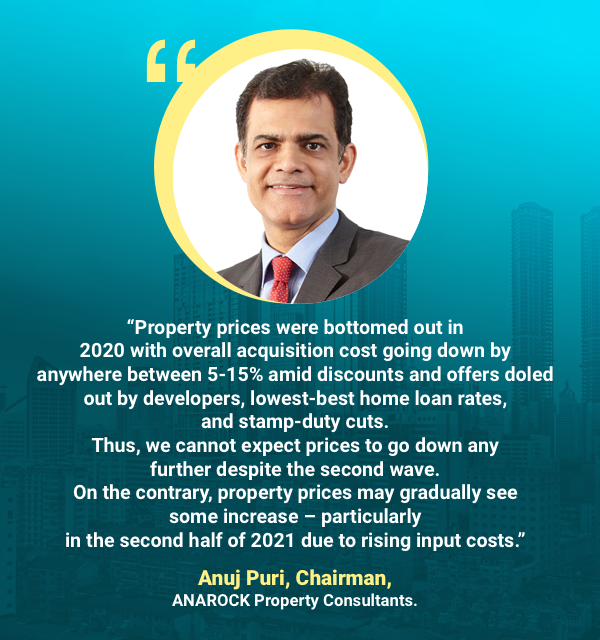“We cannot expect prices to go down any further despite the second wave. On the contrary, property prices may gradually see some increase – particularly in the second half of 2021,” said Anuj Puri, Chairman – ANAROCK Property Consultants.
In an exclusive interview with RoofandFloor, he spoke about changes in consumer preferences post-Covid, emerging trends in the realty market, and much more.
Here are the excerpts.
How is India’s residential real estate market positioned currently?
With the second covid wave receding across most cities now, we are already seeing residential activity pick momentum. Genuine buyers are presently exploring options, and enquiries have begun to see a rise.
If we are to analyse the month-on-month housing sales activity in April to June quarter, June has been the best performing month. This is the post-peak period of the second wave. As per ANAROCK research, of the total housing sales of nearly 24,570 units seen across the top seven cities (including Bangalore, Chennai, Hyderabad, Pune, Kolkata, NCR, and MMR) in Q2 2021, around 50-60% were closed in June, followed by 30% in April. The month of May – when the second wave was at its peak – saw the least activity of anywhere between 10-20%.
Are you noticing any changes in homebuyers’ preferences post-Covid?
Covid-19 presents a radically transformed real estate market, with preferences changing to accommodate new market realities. Some key trends include:
- Amid work-from-home, homebuyers now prefer to move to peripheral areas for bigger homes and a better lifestyle – at more affordable prices. The ‘walk-to-work’ concept shed much of its popularity, and WFH has become the next fulcrum for homebuying decisions. This new demand is also dictating fresh supply. Developers with landbanks in the peripheries, and even otherwise, saw it an opportune time to launch new projects there. As much as 58% of the total 1.49 lakh homes launched in FY21 are in the leading seven cities’ peripheries. In FY20, the share was 53%.
- Secondly, post the pandemic, ‘bigger is better’ is the catch-phrase in the Indian housing market. Average apartment sizes in the top cities have increased from 1,050 sq. ft. in 2019 to 1,120 sq. ft. in 2020 and further to 1,200 sq. ft. as on Q2 2021.
- Many prospective homebuyers now prefer to live in self-sustained gated communities where their entire family’s needs are sufficiently met. These housing societies offer companionship, safe and secure environment while providing amenities that reduce the need to venture out.
- Lastly, cities like Bangalore, Hyderabad, Chennai, Pune and Gurugram are now seeing growing demand for plots. Many are looking to buy land as a long-term investment.
What about property values? Has there been a market correction?

Property prices were bottomed out in 2020 with overall acquisition cost going down by anywhere between 5-15% amid discounts and offers doled out by developers, lowest-best home loan rates and stamp-duty cuts. Affordability of homes was all-time best and estimated to be 27% in FY21 for mid-income homes.
However, we cannot expect prices to go down any further despite the second wave. On the contrary, property prices may gradually see some increase – particularly in the second half of 2021.
The fact is that price rise was long overdue in residential real estate as prices have remained range-bound in the last few years, and if not for Covid-19 in 2020, we would have seen an escalation. Moreover, rising input costs (of cement, steel etc.) is now a pressing concern for developers, and there is also upward pressure on labour cost. Sooner or later, developers may be compelled to increase property prices amid the current rising inflationary trends. Hence, the price rise is inevitable. Thus, buying a home now equals buying at the lowest possible price.
How do you expect the second half of 2021 to be?
Given that housing has gained more significance amid Covid-19, we hope to see recovery from the third quarter of CY 2021. As is, the covid cases are already receding at the same speed as they had risen previously. Most large cities have started to unlock, and even the vaccination drive has picked significant momentum.
We are hopeful that sales will rise back like the last time. Moreover, we saw that the residential sector bottomed out in 2020, but it is expected to attain a new peak by 2023. However, it will be lower than the previous peak of 2014.
Your advice for RoofandFloor readers.
Buyers who are genuinely looking to purchase homes should know that it is the best time to buy. Many developers continue to offer deals and discounts while home loan rates are their lowest-best. However, amid the current rising inflationary trends of raw materials such as steel, cement, labour cost will sooner or later compel developers to increase property prices.
Even while demand may be low, the operating costs for developers have already gone up amid the second wave with many offering safety protocols to their workers on-site, taking care of their vaccinations and other medical needs etc. This will ultimately push developers to pass on the extra costs to the homebuyers. Hence, now is the best time to buy.

